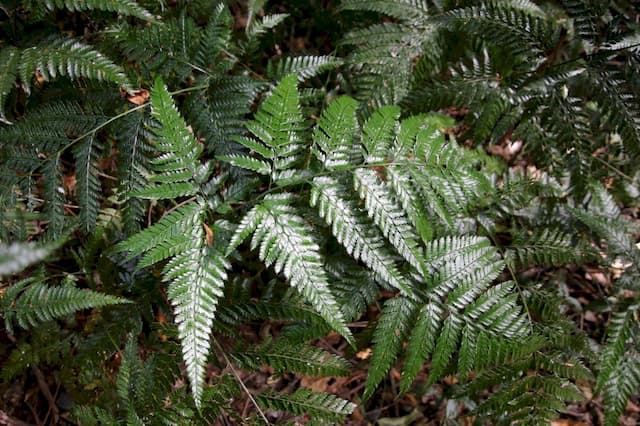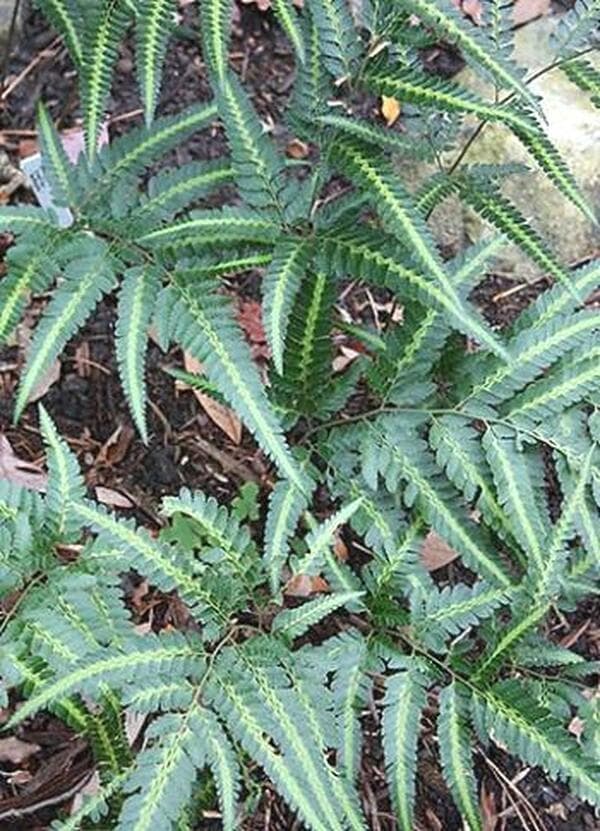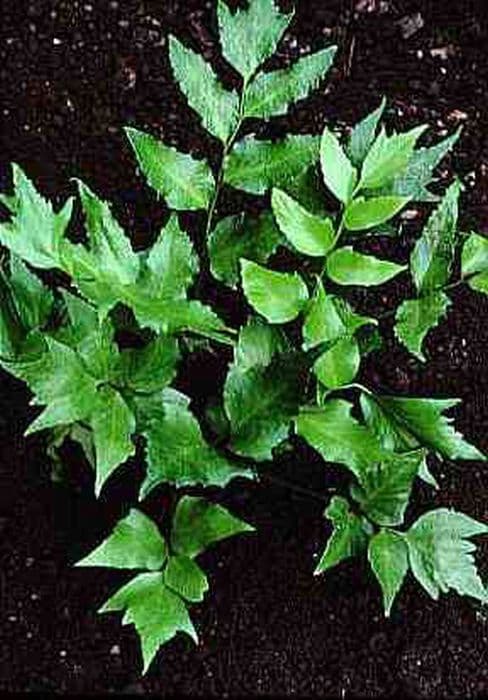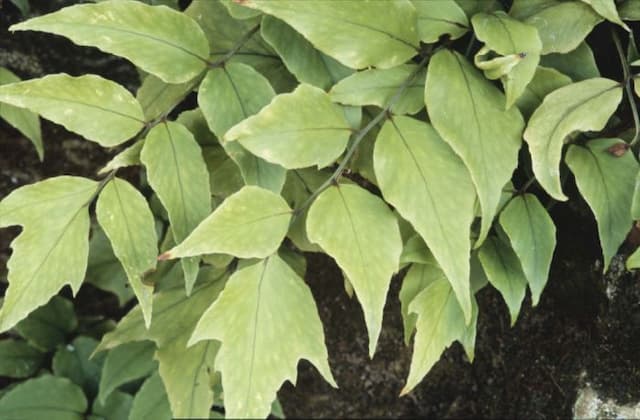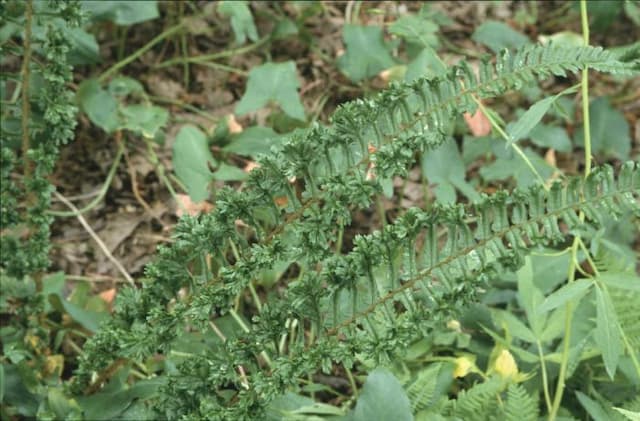Broad Buckler Fern Dryopteris dilatata 'Lepidota Cristata'











ABOUT
The plant known as Broad Buckler Fern is characterized by its distinctive fronds which add a unique texture to any garden space. These fronds are intricately divided and feature wavy or crinkly edges that give the plant a ruffled look—an appearance that is further enhanced in the 'Lepidota Cristata' variety by the presence of crests or tufts at the tip of each frond and pinnae (the leaflets that make up a frond). The texture of the fern is further accented by the scale-like structures that cover the stems and sometimes the backs of the fronds, adding a rough, almost hairy feel. The overall color palette of the Broad Buckler Fern ranges from a deep, lush green during the peak growing season, which can then transform into a yellow-green or bronze hue in response to cooler temperatures, especially in the fall. The arrangement of the fronds is elegant and arching, forming a vase-like clump that stands out strikingly against other plants or in isolation.
About this plant
 Names
NamesFamily
Dryopteridaceae
Synonyms
Broad Buckler Fern, Crested Broad Buckler Fern
Common names
Lastrea dilatata 'Lepidota Cristata', Nephrodium dilatatum 'Lepidota Cristata'.
 Toxicity
ToxicityTo humans
The plant commonly known as broad buckler fern is not typically known to be toxic to humans. There is no widespread evidence of significant toxicity in the broad buckler fern to humans, and ingestion of parts of this plant is unlikely to cause poisoning. Therefore, there are no specific symptoms associated with its toxicity to report for humans, as it is generally considered safe.
To pets
Similar to its interaction with humans, the broad buckler fern is not commonly known to be toxic to pets. Pets that ingest parts of this plant are unlikely to suffer from poisoning, and there are no well-documented symptoms of toxicity in pets resulting from the broad buckler fern. It is generally considered a non-toxic plant to pets.
 Characteristics
CharacteristicsLife cycle
Perennials
Foliage type
Deciduous
Color of leaves
Green
Height
3 feet (0.91 meters)
Spread
3 feet (0.91 meters)
Plant type
Fern
Hardiness zones
5
Native area
Europe
Benefits
 General Benefits
General Benefits- Aesthetic Appeal - Adds a lush, green presence and a ferny texture to shade gardens.
- Wildlife Habitat - Provides shelter and breeding grounds for various insects and small animals.
- Erosion Control - Helps stabilize soil in shaded areas where other plants might struggle to grow.
- Low Maintenance - Requires minimal care once established, beyond occasional watering and seasonal cleanup.
- Drought Tolerance - Once established, it can survive periods of dry weather, reducing the need for frequent watering.
- Cold Hardy - Capable of surviving in cooler climates, making it suitable for a wide range of growing zones.
- Non-Invasive - Unlike some fern species, it does not spread aggressively, making it easier to contain and manage.
- Seasonal Interest - Offers year-round visual interest, particularly valuable in predominantly green shade gardens.
 Medical Properties
Medical PropertiesThis plant is not used for medical purposes.
 Air-purifying Qualities
Air-purifying QualitiesThis plant is not specifically known for air purifying qualities.
 Other Uses
Other Uses- The Broad Buckler Fern can be used as a natural dye for fabrics, providing a variety of green hues depending on the mordant used.
- This fern can be incorporated into flower arrangements for a touch of woodland aesthetic or dried for use in everlasting floral compositions.
- The Broad Buckler Fern can be used in terrariums or bottle gardens due to its preference for high humidity and shaded conditions.
- It is suitable for planting in outdoor fairy gardens, providing an enchanting, lush backdrop for miniature scenes.
- The fronds of the Broad Buckler Fern may be used in art projects, such as pressing for botanical prints or inclusion in paper making for texture.
- This fern can be used to create natural barriers or low hedges in shady garden areas where traditional hedge plants may not thrive.
- It's a useful plant for covering unsightly features in the garden like pipes or low walls, as it can grow to be dense and bushy.
- The fern can be a teaching tool for botany or ecology lessons, demonstrating fern reproduction and the non-flowering plant lifecycle.
- For those interested in the Victorian language of flowers, the Broad Buckler Fern can represent sincerity and fascination when given as a gift.
- In thematic garden designs, such as prehistoric or dinosaur gardens, its ancient lineage and lush foliage can add authenticity to the landscape.
Interesting Facts
 Feng Shui
Feng ShuiThe Broad Buckler Fern is not used in Feng Shui practice.
 Zodiac Sign Compitability
Zodiac Sign CompitabilityThe Broad Buckler Fern is not used in astrology practice.
 Plant Symbolism
Plant Symbolism- Resilience: The broad shield fern, as Dryopteris dilatata 'Lepidota Cristata' is commonly known, thrives in shadowy forest environments, symbolizing the ability to thrive in difficult conditions and overcome adversity.
- Shelter: Its dense and spreading fronds provide cover for small animals and plants, so it represents protection and the nurturing of growth.
- Endurance: As a perennial fern, it returns year after year even after harsh winters, representing persistence and endurance through tough times.
- Elegance: The crested tips of the fronds offer a refined appearance, signifying elegance and natural beauty.
- Growth: Ferns are often associated with new growth, rejuvenation, and the unfurling of new fronds as seasons change, which can symbolize a new beginning or personal growth.
 Water
WaterThe Broad Buckler Fern requires consistent moisture and should be watered thoroughly once a week with about one gallon of water. During the growing season in spring and summer, it may need more frequent watering, especially if the weather is particularly warm or dry. Make sure the soil stays evenly moist but not waterlogged. If the plant is indoors, allow the top inch of soil to dry out slightly before watering again. Adjust the frequency if the humidity is higher, which can reduce the need for watering.
 Light
LightThe Broad Buckler Fern thrives in partial shade to full shade conditions. Ideally, it should be placed in a spot where it receives dappled sunlight or only indirect light. Direct sunlight can scorch the fronds, so avoid placing it in a location where it will be exposed to the harsh rays of the sun for prolonged periods. A north-facing garden spot or a position under a canopy of larger trees is optimal for this fern.
 Temperature
TemperatureThe Broad Buckler Fern does well in temperatures ranging from 60 to 70 degrees Fahrenheit during the day and should not be subjected to temperatures below 50 degrees Fahrenheit for prolonged periods. Its hardiness allows it to survive brief dips into the high 30s, but the ideal temperature range for this plant is within the moderate to cool spectrum.
 Pruning
PruningThe Broad Buckler Fern should be pruned to remove dead or damaged fronds, which promotes healthy growth and improves the plant's appearance. Pruning is best done in the spring before new growth starts. This is also a good time to remove any old fronds that have survived through the winter, as fresh, new fronds will soon replace them. Pruning is typically only needed once a year.
 Cleaning
CleaningAs needed
 Soil
SoilThe Broad Buckler Fern prefers a well-draining soil mix rich in organic matter with a pH range of 5.5 to 6.5. A mix consisting of one part garden soil, one part peat moss or leaf mold, and one part perlite or coarse sand is ideal for maintaining the right balance of moisture and aeration.
 Repotting
RepottingBroad Buckler Ferns should be repotted every two to three years or when the roots have filled the pot. It's best to repot in the spring just before new growth begins.
 Humidity & Misting
Humidity & MistingThe Broad Buckler Fern thrives in high humidity conditions, ideally between 60% to 80%. It benefits from regular misting or a humidifier to maintain the necessary humidity levels.
 Suitable locations
Suitable locationsIndoor
Keep in bright, indirect light with high humidity.
Outdoor
Plant in dappled shade; protect from harsh sun and wind.
Hardiness zone
4-8 USDA
 Life cycle
Life cycleDryopteris dilatata 'Lepidota Cristata,' commonly referred to as the Crested Broad Buckler Fern, begins its life as a spore released from sporangia on the underside of mature fronds. These spores germinate into a prothallus, a small, heart-shaped gametophyte, that holds both male and female reproductive organs. Upon fertilization, the zygote develops into a new sporophyte, initially as a small fernlet emerging from the prothallus. As the plant matures, it forms a rosette of pinnate fronds with the characteristic crested tips, which unfurl from tightly curled 'fiddleheads' or croziers. The Crested Broad Buckler Fern grows and expands through rhizomes, eventually forming dense clumps. This fern prefers shaded woodland environments and has a perennial life cycle, surviving for many years, with each mature frond capable of producing new spores to restart the life cycle.
 Propogation
PropogationPropogation time
Spring to Summer
The propagation of the Broad Buckler Fern, commonly known as Dryopteris dilatata 'Lepidota Cristata', is typically undertaken during the spring or early summer when the plant is actively growing. Spore collection and sowing is the most popular method for propagating this fern species. Mature fronds with ripe spore cases are collected and the spores are sown on the surface of a fine, sterile, moist compost, often a mix of peat and sand or a peat-substitute and perlite. These should be kept in a warm, shaded environment with high humidity, somewhere around 70 degrees Fahrenheit (around 21 degrees Celsius), until germination occurs. After the spores have germinated and the young ferns have developed a few leaves, they can be carefully potted on into individual containers to grow on before being planted out.
